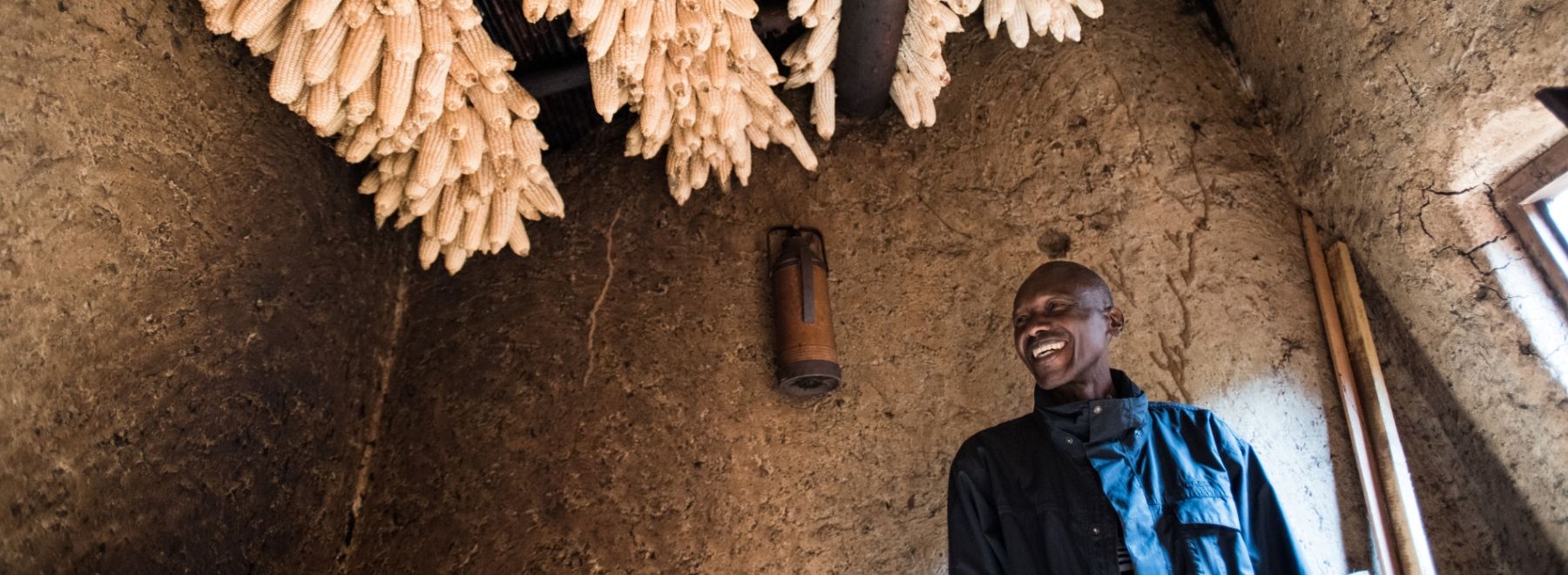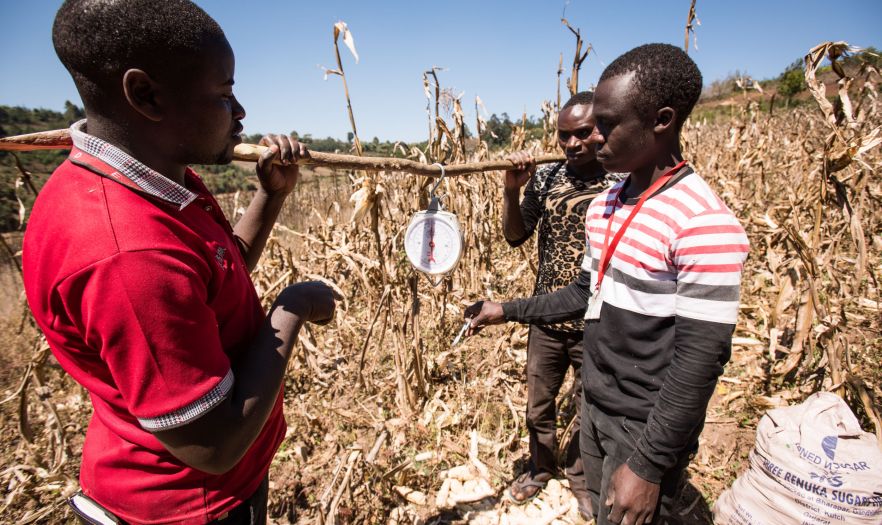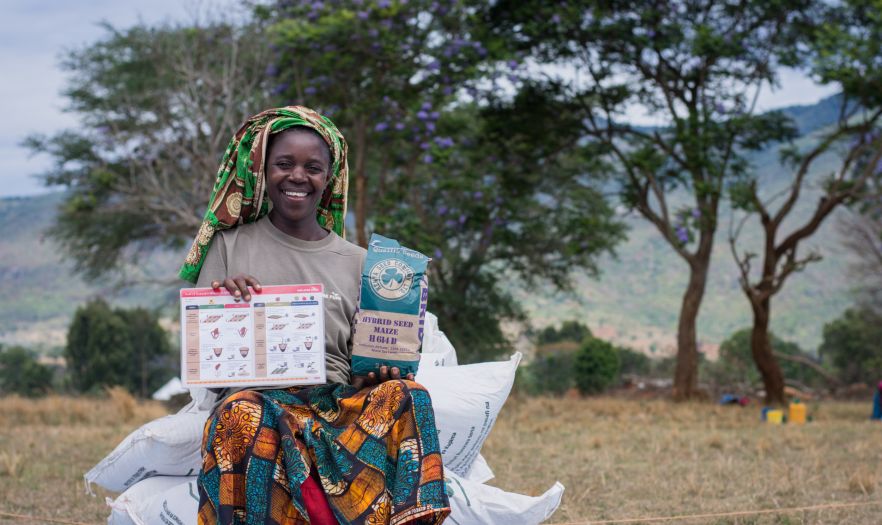What is social return on investment?

Learn how One Acre Fund measures the impact of every dollar our donors contribute.
One Acre Fund finances its operations with a mix of farmer purchases and donor dollars. Farmer purchases cover most of our daily field operations, and donor funds help us grow and innovate. This revenue mix keeps us accountable to farmers and financially stable. For every dollar we spend, we aim to put more income in farmers’ pockets. We call this our "social return on investment” or SROI.
What exactly does SROI measure?
Put simply, SROI measures the new farmer profit created for every dollar of donor funding invested. The more efficient we become, the more impact we create with each donor dollar.
In 2022, the farmers that One Acre Fund served directly produced $3.90 in new income and assets for every $1 in donor funds, or an SROI of 3.9, representing strong impact efficiency for the poverty levels of the farm families we reach.
As we grow, we aim to fund more and more of our operations through farmer purchases, and make each donor dollar go further.
How do we calculate SROI?
To calculate SROI, we take the total impact of a program in terms of new farmer income generated ($), and then divide it by the donor cost of operating that program ($). On a per-farmer basis, SROI is equivalent to the average incremental profit per farmer divided by the average donor subsidy per farmer. For example, suppose that last year, a country program served 100,000 farmers and generated an estimated $100 of new income per farmer. This resulted in a total impact of $10 million. Against that, suppose One Acre Fund spent $2 million in donor funds to create that impact. The SROI of that program would be $10 million divided by $2 million, or 5. That means that for every $1 donor dollar invested in that country program, we generated $5 in new farmer income. Or – equivalently, we created $100 of new income impact per farmer and spent $20 in donor funds per farmer to generate that impact: $100/$20, or an SROI of 5.
How do we use SROI?
SROI is a powerful metric in that it enables us to combine impact and cost, to ultimately show how cost-effectively we’re achieving impact as a whole and within specific areas of operations. For instance, we aspire to generate at least $4 in incremental profit for farmers for every $1 in donor subsidy spent on our core program, which we believe is strong for the population we serve.
The biggest use of SROI at One Acre Fund is to inform internal decision-making. As with all donor-supported organizations, we have limited resources and must make decisions as to how we deploy those resources to maximum effect. SROI provides a common metric we can use to analyze performance of our many programs and countries. Of course, SROI should not be the sole criteria for resource allocation decisions. One Acre Fund also considers a number of others, such as need-level, scalability, and non-income impacts, to determine how much to invest across our increasingly diverse portfolio.
What does our overall SROI look like?
Despite material progress in reducing our net cost per farmer, the inherent volatility of agricultural yields and profits due to weather, pests, and price fluctuations has meant that our SROI does fluctuate year to year. However, over the past five years, we have seen a generally positive trend, with SROI increasing from 2.8 to 3.9 in our core program (and 1.6 to 3.7 all-in), comparing 2018 to 2022. We believe these are strong ratios for an at-scale program serving farmers at the poverty level of our target population.
Over time, One Acre Fund has steadily improved the impact of our program, by introducing both improvements to existing products (e.g., higher-yielding seeds, more productive planting techniques for maize) and new products (e.g., agricultural lime, improved storage bags). However, many of the crops smallholders plant are harvested annually, in the agricultural season. As a result, the effects of product improvements are often overshadowed by the material influence that weather, pests, and market prices have on the yields and profits farmers generate from their crops in a given year. This is demonstrated in the fluctuations in the chart above.
One Acre Fund has steadily improved our costs, both in terms of core program cost per farmer and all-in cost per farmer. In particular, One Acre Fund has been able to drive meaningful cost efficiencies in R&D and shared service costs, as we can control what we spend in those areas. Our core program cost per farmer has improved through economies of scale in input ordering and better farmer to field officer ratios, though in part offset by lower farmer repayment and re-enrollment rates in recent years due to weather and pest challenges.
How does SROI differ across countries?
To inform internal decision-making, One Acre Fund calculates different SROI targets for each country and/or program based on its scale point and need-level. Highlighting the variation in SROI in different countries, below is a chart of average core program SROI in several of our core countries of operation.
Note: These numbers are 3-year averages from 2020 - 2023
| Country | NPV IMPACT ($) PER FARMER | DONOR SUBSIDY PER FARMER | SROI (IMPACT/COST) PER FARMER |
|---|---|---|---|
| Kenya | $131 | $70 | 2.5 |
| Rwanda | $120 | $17 | 7.3 |
| Burundi | $129 | $18 | 8.4 |
| Tanzania | $62 | $61 | 1.0 |
| Malawi | $143 | $3 | 18.3 |
| Nigeria | $328 | $37 | 9.2 |
| Whole Program* | $124 | $33 | 3.8 |
* “Whole program” includes smaller countries of operation and weights each country's SROI by the number of farmers reached
How does SROI support resource allocation?
Using SROI to allocate resources is part of the pact we make with our staff, our funders, and most importantly our clients, to generate the most social good for every dollar we deploy. Farmers count on us to use our resources responsibly—doing so means more families can put food on their tables and create brighter futures for their children.
We share here two examples of how SROI has supported resource allocation:
How should resource levels change for each of our core program countries?
In 2016, Kenya’s core program SROI was well above target. As a result, we challenged our Kenya team to identify opportunities for faster growth (more resource investment), which resulted in a strategy to increase market penetration and expand outwards. Conversely, Rwanda’s core program SROI was below its target, due in particular to environmental factors. As a result, we prioritized improving efficiency before investing for fast growth, and our Rwanda team responded by trimming 20% of its budget.
Among our pipeline of research and development trials, which ones should we scale up, and at what investment level?
Although harder to calculate, given we are projecting future impact (based on several assumptions) and then discounting to present value, we can generate an SROI for trials in our R&D pipeline, and choose to invest in scaling up those with the highest projected SROI and scale. For instance, tree planting has proven in our innovation trials to have an extremely high SROI (and highly scalable) across many contexts. This category will receive enhanced investment in the coming years.
What are our SROI goals?
Looking ahead, while any single-year is difficult to forecast, we do see a strong path to increasing our SROI over time on both a core program and all-in basis, through improvements to both impact and cost. For instance, to increase impact, One Acre Fund is innovating a poultry program in key countries and using the tools of precision agriculture to start making site-specific seed and fertilizer recommendations. On the cost side, One Acre Fund is projecting major efficiencies through technology. For instance, we are continuing to roll out tablets to our front-line field staff in all our countries of operation, to shift core functions like marketing and enrollment from paper; and to supplement training and repayment collection.
As we grow bigger, our aim is to make each dollar go further. In many of our countries, we have already built the systems to serve farmers at scale. We have global teams that can support shared needs, like purchasing farm inputs in bulk. This enables us to increase our impact without increasing costs. We believe it’s possible to double our impact from 2020 - 2024, using the same resources we have today.
In addition, while we highly value SROI as an important metric, One Acre Fund also generates meaningful impacts beyond financial impact, and therefore not currently captured by SROI. For instance, One Acre Fund builds resilience among our clients, by increasing asset value, asset diversity, insurance coverage, and safety net networks relative to non-One Acre Fund farmers. We are also working to achieve non-financial outcomes for clients, including outcome areas where we have strong evidence today (such as food security) and new areas we see as important to holistic improvements for our clients (such as nutrition, agrobiodiversity, and soil health).
Explore the impact of SROI
This article explores why we believe social return on investment is an underutilized yet surprisingly flexible tool for making strong resource allocation decisions that maximize nonprofit impact.
Using a social return on investment framework, organizations can estimate the future impact, cost, and scale of programs before they begin, and allocate resources for greater impact.

